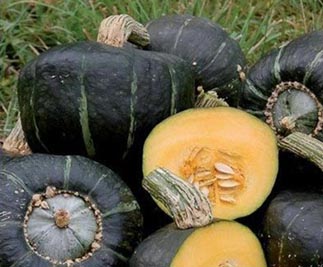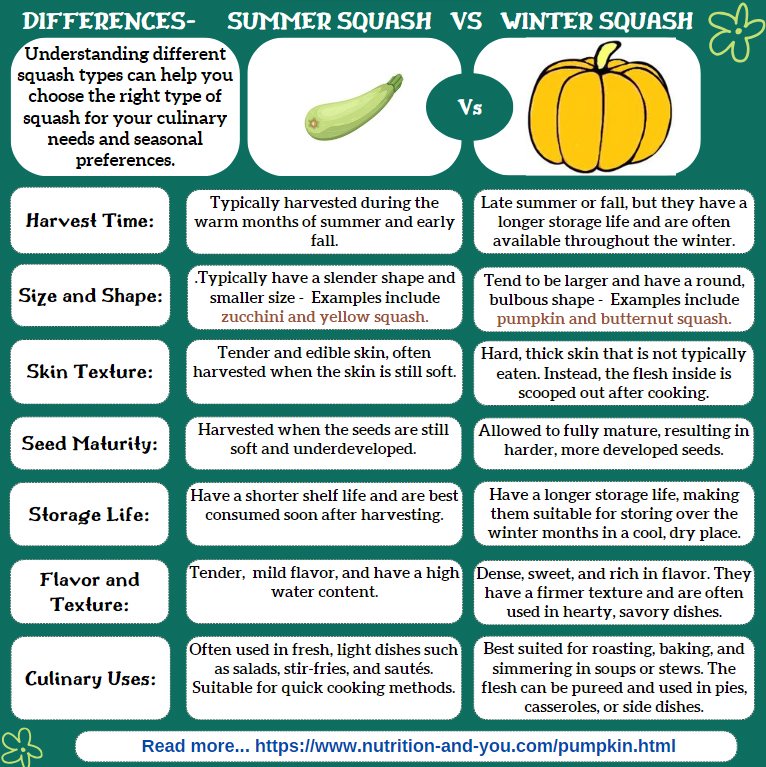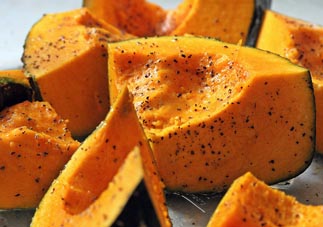Buttercup Squash Nutrition facts
Buttercup squash, a popular variety of winter squash in the Cucurbita maxima (Pumpkin) subfamily, is known for its thick, dark-green skin with light stripes and a blockier shape compared to kabocha squash. Inside, it boasts deep yellow to orange flesh that is pleasantly sweet.
Buttercup squash features a protruding lighter gray-green (glaucous) "button" surrounded by a circular scar at the blossom end of the fruit.
Botanical name: Cucurbita maxima (Buttercup type).
 |
Buttercup squash is characterized by its dense, starchy, grainy, orange-yellow flesh, with a flavor and texture often likened to sweet potatoes.
Inside, the central hollow cavity is filled with numerous large, flat seeds reminiscent of pumpkin seeds, weighing approximately 2 to 4 pounds.
Harvesting
In general, buttercup fruit is considered sufficiently mature for removal from the vine at 45 days after flowering, indicated by the entire foliage becoming senesced and the stem turning corky, brown, and hard.
After the harvest, most farmers cure them by simply storing at room temperature, around 70 degrees F, for 2-3 weeks before transferring them to a cool, dry place such as the basement or garage for long-term storage.
Some popular buttercup squash varieties grown in the U.S. include:
'Bonbon'- This variety is medium duration, green in color, and large in size.
'Burgess'- Conversely, this variety is a short-duration crop but produces medium-sized squash.
Discover the differences between Summer and Winter variety squashes - refer to the infographic below:
 |
Health benefits of Buttercup Squash
Buttercup squash shares a similar nutrition profile with kabocha squash. It is a low-calorie winter squash variety; hold just 34 calories per 3.5 oz (100 g).
It is also an excellent source of soluble and insoluble dietary fiber, and it contains no saturated fats or cholesterol.
Buttercup squash is a gluten-free, making it a suitable substitute for individuals with gluten sensitivities, such as those with celiac disease.
Buttercup squash is rich in carotenoids and vitamin A, providing about 1370 IU per 3.5 oz (100 g) and 820 µg of ß-carotene. Vitamin A is an important antioxidant that supports cell growth, mucosal repair, fights cancer, and promotes good vision.
Together with vitamin A, these polyphenolic pigment compounds help scavenge harmful oxygen-derived free radicals and reactive oxygen species (ROS) from the body, which play roles in cancers, aging, and various inflammatory disease conditions.
Fresh Buttercup squash contains relatively higher amounts of vitamin C (20% of RDA per 3.5 oz), pyridoxine, and thiamin compared to pumpkin. Vitamin C is essential for collagen synthesis in bones, cartilage, and blood vessels, and aids in iron absorption.
It is also a good source of folates, providing 24 µg or 6% of RDA per 3.5 oz. Folate is a cofactor involved in cell division and DNA synthesis, helping prevent neural tube defects in newborns when taken during early pregnancy by expectant mothers.
Buttercup squash is low in sodium (3 mg/100 g) but contains ample amounts of potassium (350 mg/100 g), an important intracellular electrolyte. Potassium is a heart-friendly electrolyte that helps decrease blood pressure and heart rate by counteracting the effects of sodium.
Moreover, it contains significant amounts of other B-complex vitamins such as pyridoxine, thiamin, pantothenic acid, riboflavin, and minerals like copper, selenium, calcium, iron, manganese, phosphorus, and zinc.
| Principle | Nutrient Value | Percent of RDA |
|---|---|---|
| Energy | 34 Kcal | 1.7% |
| Carbohydrates | 8.59 g | 6.6% |
| Protein | 0.95 g | 1.7% |
| Total Fat | 0.13 g | <1% |
| Cholesterol | 0 mg | 0% |
| Dietary Fiber | 1.5 g | 4% |
| Vitamins | ||
| Folates | 24 μg | 6% |
| Niacin | 0.500 mg | 3% |
| Pantothenic acid | 0.188 mg | 4% |
| Pyridoxine | 0.156 mg | 12% |
| Riboflavin | 0.062 mg | 5% |
| Thiamin | 0.030 mg | 2.5% |
| Vitamin-A | 1370 IU | 45.5% |
| Vitamin-C | 12.3 mg | 20.5% |
| Electrolytes | ||
| Sodium | 4 mg | <0.5% |
| Potassium | 350 mg | 7% |
| Minerals | ||
| Calcium | 28 mg | 3% |
| Iron | 0.58 mg | 7% |
| Magnesium | 14 mg | 3.5% |
| Manganese | 0.163 mg | 6% |
| Phosphorus | 23 mg | 3% |
| Selenium | 0.4 µg | <1% |
| Zinc | 0.21 mg | 2% |
| Phyto-nutrients | ||
| Carotene-ß | 820 μg | -- |
| Crypto-xanthin-ß | 0 μg | -- |
| Lutein-zeaxanthin | 38 μg | -- |
Selection and Storage
In the U.S., buttercup squash is available from fall to mid-winter months in farmers' markets.
While choosing buttercup squash, avoid those with blemished, soft, or rotting stems, as well as any that are damaged or have cuts or punctures.
Buttercup squash has a thick, hard rind, allowing it to be stored for up to six months in a cool, dry place.
However, once opened its sections should be used in cooking promptly. If you intend to store cut sections for extended use (up to 1-2 days only), wrap them in cellophane and place them in the refrigerator set at high relative humidity.
Preparation and Serving methods
Buttercup squash is among the popular winter vegetables in the U.S., Canada, and Mexico, often serving as a substitute for butternut, kabocha, or pumpkin in similarly cooked recipes.
Its dense, starchy, grainy, orange-yellow flesh closely resembles that of sweet potatoes.
Buttercups are renowned for their dry-textured flesh, which retains its shape when used in whole baked dishes, stuffed recipes, stews, and curries. It is well-suited for various cooking methods including baking, roasting, steaming, stuffing, boiling, and sautéing.
While its tough rind is edible, some chefs prefer to peel it before consumption.
In a way similar to kabocha, buttercup squash can be sliced into rings or cubes and incorporated into a myriad of recipes including soups, salads, stews, gratins, sandwiches, and risotto.
 |
| Baked buttercup. Courtesy: Sue Thompson. |
Here are some serving tips:
Buttercup is used in a popular creamy soup in Brazil, Colombia, and Peru.
Raw grated buttercup is a delightful addition to salads, imparting a sweet crunch and a burst of yellow-orange hue.
Similar to kabocha or delicata squash, buttercup squash is halved, seeded, stuffed with bread, grains, bacon, meat, cheese, mushrooms, leafy greens (such as spinach), and herbs, and then baked in the oven.
Enjoy buttercup squash gratin with complementary vegetables or sausage.
Mashed or pureed buttercup squash serves as a healthy alternative to mashed potatoes.
Whether baked, pureed, or mashed, buttercup squash can be used as a filling for empanadas, enchiladas, and ravioli, or incorporated into desserts, pies, puddings, and bread.
Gently toasted buttercup squash kernels can make a healthy, satisfying snack.
Safety Profile
Allergic reactions to buttercup squash are uncommon, making it safe for consumption by pregnant women and infants. (Medical disclaimer).
You may also like to read ≺≺-
≺≺- Butternut squash Nutrition facts.
≺≺- Spaghetti squash Nutrition facts.
≺≺- Acorn squash Nutrition facts.
≺≺- Delicata squash Nutrition facts.
≺≺-Pattypan squash Nutrition facts.
≻≻-Back to Vegetables from Buttercup Squash nutrition. Visit here for an impressive list of vegetables with complete illustrations of their nutrition facts and health benefits.
≻≻-Back to Home page.
Further reading:
Kabocha and Buttercup Squash for Western Oregon Gardens- Oregon State University Extension Service.
Watch your garden grow- University of Illinois Extension (PDF).